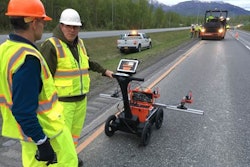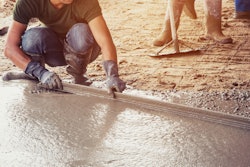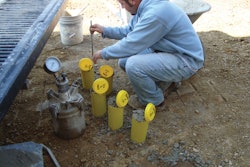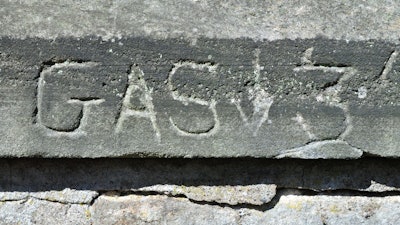
The construction industry, especially concrete contractors, stands at the intersection of the most technologically advanced jobsite and potentially significant infrastructure spending. Considering that the labor shortage remains an ongoing concern for contractors, companies, and jobsites, more are turning to technology to ensure their jobsites are safe and unseen dangers are adequately identified and marked.
One challenge in North America is that developers, contractors, and companies continue to add underground utilities but rarely remove outdated or no longer used technology, and there is no nationwide utility database. There is often a question of who owns what utility and who can handle which utility.
The global GPR market is expected to grow from $502.4 million in 2022 to $699.9 million by 2026 — more than 39%.
Increasingly, building owners, architects, engineers, and contractors want imaging to be performed to correctly identify utilities and structural elements ahead of beginning to dig. But just knowing something unseen exists isn’t enough. Companies must still find it and verify the location of utilities to comply with safety mandates and best practices. Ground-penetrating radar (GPR) is one of the preferred tools and according to Global Industry Analysts, the global GPR market is expected to grow from $502.4 million in 2022 to $699.9 million by 2026 — more than 39%.
Avoiding A Costly Accident
One of the most significant dangers on the jobsite is accidentally striking a utility. There is a utility strike in North America every 10 seconds on average. In 2018, workers reported more than 330,000 underground utility strikes in the U.S. and more than 11,000 in Canada. Those numbers represent an increase of about 13.5% since 2015.
It’s a problem that doesn’t have to exist, and there is a straightforward solution. In eliminating the threat of accidentally striking a utility line, organizations can save money—not to mention headaches and the potential for loss of human life. The industry’s most commonly cited research, a Purdue University study, found that for every dollar spent on utility detection, companies can save $4.62. Other estimates show cost savings could reach $18 for every dollar spent. The savings can total billions of dollars annually. Shutting down a project because of a utility strike can easily cost companies at least $2,000 per hour.
There are two primary approaches to understanding buried utilities: calling for a utility detection service or GPR.
Two primary technologies help crews detect underground utilities:
- Electromagnetic locators - Electromagnetic locators effectively locate metal and metallicized utilities, while GPR can help locate other buried items, including plastic pipes. It is also ideal for locating rebar and post-tension cables often found in larger buildings.
- GPR - GPR is the most recognized and valuable tool for investigating objects embedded within concrete structures. Its accuracy and ability to locate items, with little to no disruption, make it the preferred tool for scanning.
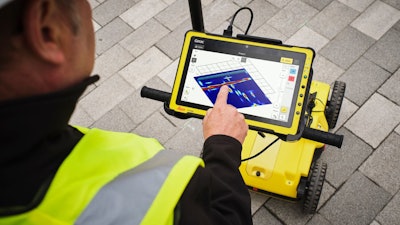 Ground-penetrating radar, like the technology seen here with the Leica DSX, can help contractors locate utility lines, voids in the concrete, rebar, post-tension cables, and more. Many models come available with software to automate data analysis to create a 3D map of the results for easy visualization.Leica Geosystems Inc.
Ground-penetrating radar, like the technology seen here with the Leica DSX, can help contractors locate utility lines, voids in the concrete, rebar, post-tension cables, and more. Many models come available with software to automate data analysis to create a 3D map of the results for easy visualization.Leica Geosystems Inc.
Best Practices For Contractors
GPR will not identify rebar types. However, it is ideal for looking into a concrete slab, making it indispensable for the nation’s ongoing infrastructure initiative.
Before collecting any data, contractors should understand what information the customer needs. They should also understand more about the area they are scanning, including how old the concrete is, whether the area will be free of obstructions, and what other safety considerations are necessary.
With more teams using GPR, an increasing number of jobsites have multiple GPR contractors on-site at one time. To avoid confusion and make sure collected data is usable, teams must agree to a standardized depiction of a subsurface embedment.
It sounds simple enough, but contractors need to be familiar with operating GPR, including its limitations. Users should know how and when to calibrate the device and program its settings to collect the best data based on the site specifics.
Crews should also follow industry best practices and generate proper markings to minimize confusion on-site with other contractors and personnel.
- For example, a black lumber crayon or marker is preferred when marking on exposed concrete if it isn’t the natural exposed surface. If black markings are inappropriate or challenging to see, another appropriate color — except red — may be used. However, the color must be expressly noted in the pre-job and post-job walkthroughs.
- Workers should avoid making temporary markings. If required — on finished surfaces, such as polished concrete, tiled floors and carpet, for example — chalk, tape, or other appropriate devices can be used; contractors should also take photos of temporary markings.
- Imaging contractors should mark any embedment interpreted as conduits in red, where appropriate. If red is inappropriate, another color may be used and noted during pre-job and post-job walkthroughs. However, the color should not be the same color used to denote reinforcement to avoid confusion.
- Because GPR cannot initially identify the size or width of an embedment, contractors should mark an exclusion zone of at least 1 inch on either side of an identified embedment’s center point.
What Does This Mean For Concrete?
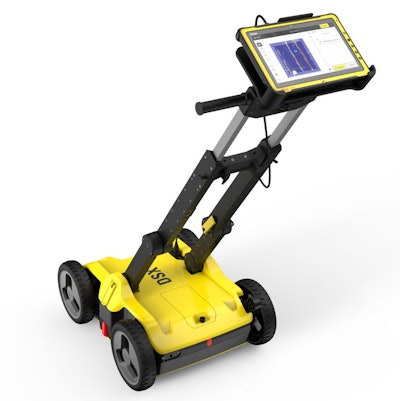 GPR devices can range in size from large to handheld. Depending on the size of the scanning area and situation, some jobs may be better suited for a walkable scanner. Consider the antenna frequency as well; a lower frequency antenna will provide deeper penetration, but targets must be larger to be detected.Leica Geosystems Inc.
GPR devices can range in size from large to handheld. Depending on the size of the scanning area and situation, some jobs may be better suited for a walkable scanner. Consider the antenna frequency as well; a lower frequency antenna will provide deeper penetration, but targets must be larger to be detected.Leica Geosystems Inc.
GPR will not identify rebar types. However, it is ideal for looking into a concrete slab, making it indispensable for the nation’s ongoing infrastructure initiative.
The top limit for most work in concrete is 28 in. However, electrical conductivity, aggregate size, air entrainment, water content, and admixtures will reduce the depth of GPR’s effectiveness.
Contractors should set the depth to be at least 50% deeper than the expected depth of the objects. For example, the depth window should be at least 15 in. for a 10-in.-thick slab.
GPR entered the market decades ago, and general awareness has increased over the years. It is becoming more prevalent as the price falls and contractors become less tolerant of mishaps and utility strikes. Interpreting the data and positioning it once collected remain significant questions for many contractors. The right solution can mitigate any concerns contractors may have, and any reticence to adopt is primarily based on misinformation.
Accidentally hitting a utility is a pure cost to an organization’s bottom line, and the cost of damage is increasing. Given this, companies should recognize they’re losing money by hitting utilities and move to adopt technology that can save them time, money and headaches.
Contractors should think about their liabilities, invest in the tech, and see how profitable they can be. Doing so will save time (and rework), money, and lives. If you’re going to be held liable for any utility strikes, why not spend the money and adopt technology upfront to create “a safe system at work?”
About the author
Simon Pedley has been involved in the utility detection market for more than 16 years, providing technical support, field support, and training during much of his career. As a detection solutions specialist for Leica Geosystems, he focuses on helping professionals in surveying, engineering and construction understand and implement technology to achieve damage prevention, safety monitoring, and high-value utility mapping.





